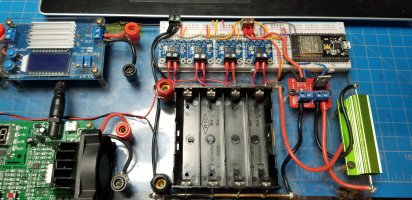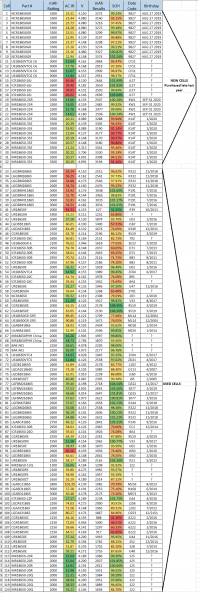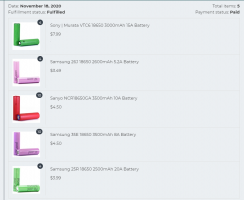Wolf
Moderator
- Joined
- Sep 25, 2018
- Messages
- 2,009
That's going to require a bunch of code writing and hardware that my aging brain is going to explode with. Nevertheless I am more than willing to try it with assistance from some brilliant sketch writer. I have no problem getting the hardware and such together.* To simulate morning transition from battery to solar power, gradually lower draw over an hour or so, smoothly switching over to charging.
I'm expecting virtually no balancing current flowing between the cells, because any balancing current would be overshadowed by the charging current.
In the meantime while I wait for some assistance with that avenue of testing I am running some standard C/D/C cycles.
I have increased the rest period to 30min between the cycles to allow the cells to equalize. This was necessary for the second set of cells which were different chemistries and different IR.
I will explain.
OK first test. 4 Sony NCR18650GA cells.
Cell 1 NCR18650GR 23.440mΩ
Cell 2 NCR18650GR 23.730mΩ
Cell 3 NCR18650GR 24.280mΩ
Cell 4 NCR18650GR 23.510mΩ
This is the trace of completed C/D/C cycles. This test was charge to 4.1V@1A discharge to 3.0V @ 1A, 10 min rest between.
As you can see very little difference in the cells response to the load. The glitches at 7:00 was some adjustments being made to the iCharger X8.

The second set of cells were a little more radical. I also changed the voltage to 4.2V all other parameters stayed the same.
Cell 1 #16 39.43mΩ 4.150V ICR189650-26J
Cell 2 #17 39.74mΩ 4.146V ICR189650-26J
Cell 3 # 21 13.70mΩ 4.132V INR18650-25R
Cell 4 # 22 14.04mΩ 4.130V INR18650-25R
Cells with different chemistry similar capacity and vastly different IR.
Initially I had a 10 min rest but after looking at the trace decided to give the rest 30 min to allow equalization to occur.
Observe how each cell responds to the load.

There you have it.
More tests coming up.
Wolf
Last edited:












